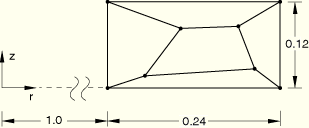
Products: ABAQUS/Standard ABAQUS/Explicit
CAX3 CAX3H CAX3T CAX4 CAX4H CAX4I CAX4IH CAX4R CAX4RH CAX4RHT CAX4RT

Linear elastic, Young's modulus = 1.0 × 106, Poisson's ratio = 0.25.
For coupled temperature-displacement elements dummy thermal properties are prescribed to complete the material definition.
Loading for Step 1:
Displacement boundary conditions applied to all exterior nodes: ![]() 10–3
10–3![]() ,
, ![]() 10–3
10–3![]() .
.
Nonuniform body force: To maintain a constant shear stress ![]() 400 and preserve equilibrium, an equilibrating body force, BZNU, is defined in user subroutine DLOAD as BZNU
400 and preserve equilibrium, an equilibrating body force, BZNU, is defined in user subroutine DLOAD as BZNU ![]() –400
–400![]() , where
, where ![]() is the radius of the integration point.
is the radius of the integration point.
In the ABAQUS/Explicit simulations this step is followed by an intermediate step in which the model is returned to its unloaded state.
Loading for Step 2:
Displacement boundary conditions applied to all exterior nodes: ![]() 10–2
10–2![]() ,
, ![]() 10–2
10–2![]() .
.
Loading for Step 3:
Displacement boundary conditions applied to the deformed geometry of Step 2 at all exterior nodes: ![]() 10–3
10–3![]() ,
, ![]() 10–3
10–3![]() .
.
Nonuniform body force (as described for Step 1): BZNU ![]() –400
–400![]() .
.
In the ABAQUS/Standard simulations this step is defined as a perturbation step; in the ABAQUS/Explicit simulations a velocity boundary condition that gives rise to the perturbation is specified instead.
The analytical results for each step are presented below.
CAX3 elements.
User subroutine DLOAD used in eca3sfp5.inp.
CAX3H elements.
User subroutine DLOAD used in eca3shp5.inp.
CAX4 elements.
User subroutine DLOAD used in eca4sfp5.inp.
CAX4H elements.
User subroutine DLOAD used in eca4shp5.inp.
CAX4I elements.
User subroutine DLOAD used in eca4sip5.inp.
CAX4IH elements.
User subroutine DLOAD used in eca4sjp5.inp.
CAX4R elements.
User subroutine DLOAD used in eca4srp5.inp.
CAX4RH elements.
User subroutine DLOAD used in eca4syp5.inp.
CAX4RHT elements.
User subroutine DLOAD used in eca4typ5.inp.
CAX4RT elements.
User subroutine DLOAD used in eca4trp5.inp.
CAX6 elements.
User subroutine DLOAD used in eca6sfp5.inp.
CAX6H elements.
User subroutine DLOAD used in eca6shp5.inp.
CAX6M elements.
User subroutine DLOAD used in eca6skp5.inp.
CAX6MH elements.
User subroutine DLOAD used in eca6slp5.inp.
CAX8 elements.
User subroutine DLOAD used in eca8sfp5.inp.
CAX8H elements.
User subroutine DLOAD used in eca8shp5.inp.
CAX8R elements.
User subroutine DLOAD used in eca8srp5.inp.
CAX8RH elements.
User subroutine DLOAD used in eca8syp5.inp.
CAX3T elements.
CAX4RT elements.
User subroutine VDLOAD for the ABAQUS/Explicit simulations.